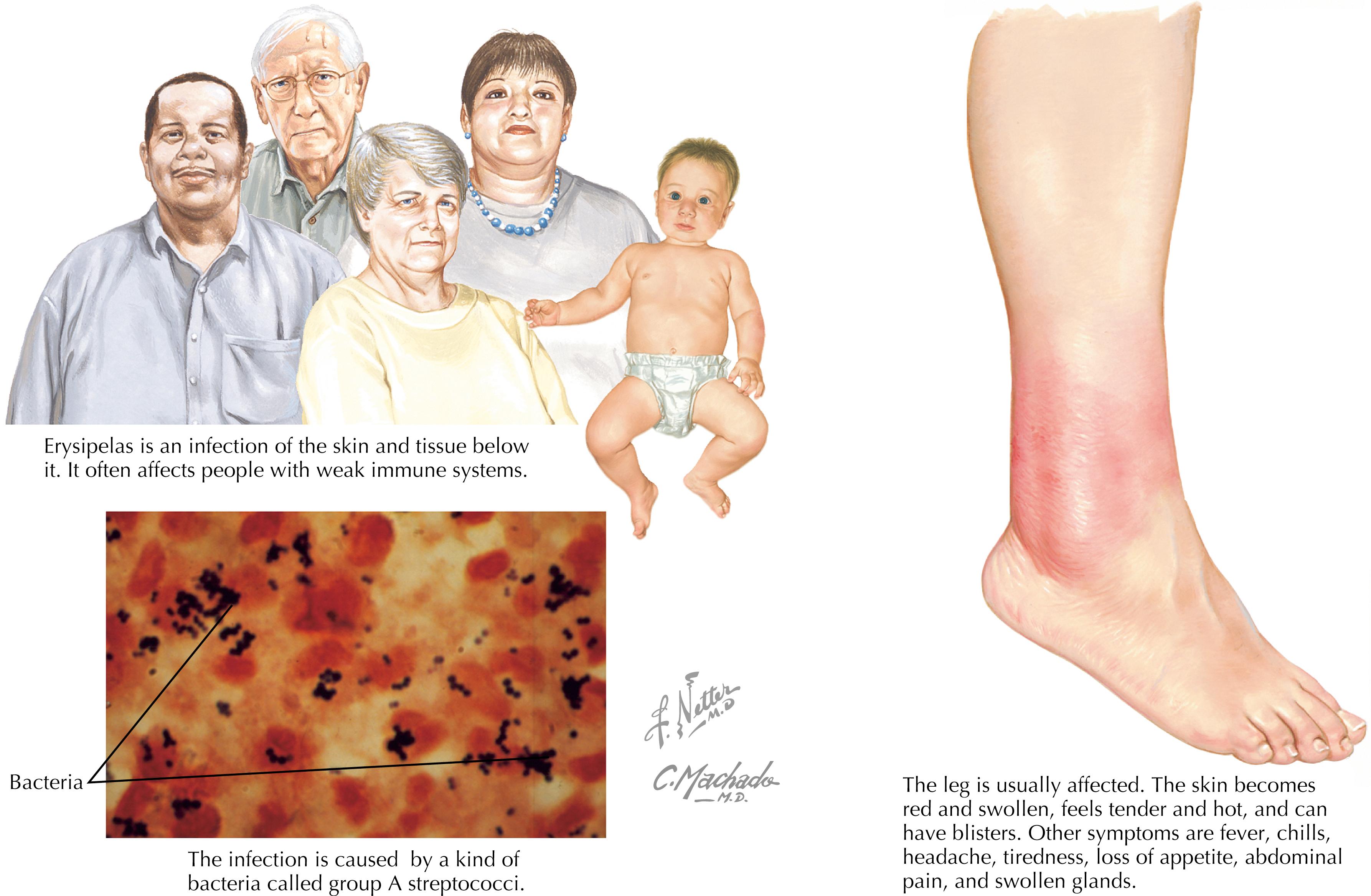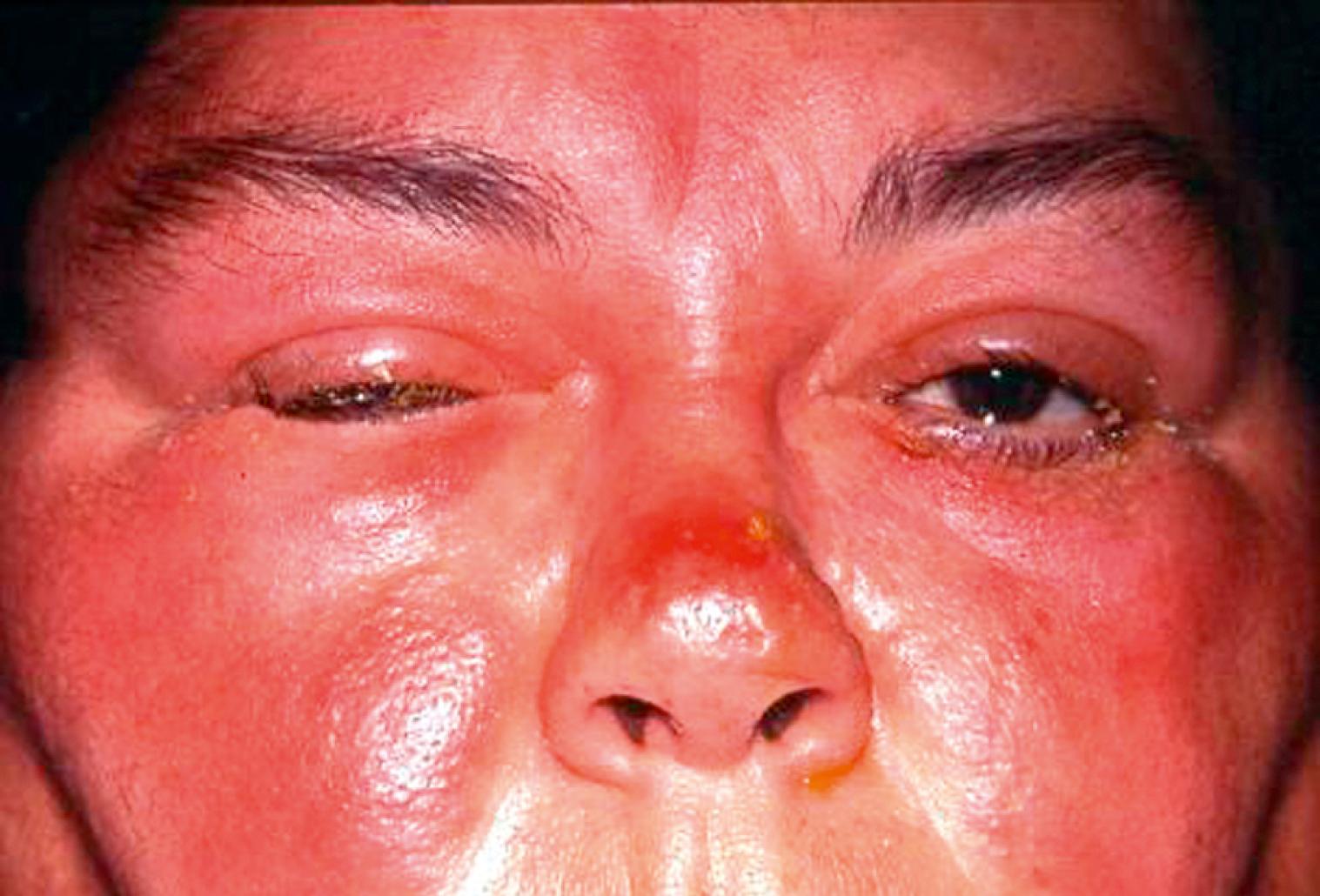Physical Address
304 North Cardinal St.
Dorchester Center, MA 02124
Pathologically, cellulitis is defined as a diffuse area of soft tissue infection characterized by leukocytic infiltration of the dermis, capillary dilatation, and proliferation of bacteria. Clinically, cellulitis is recognized as an acute infection of the skin characterized by localized pain, pinkish erythema, swelling, heat, and a diffuse, indistinct border. Erysipelas is similar to cellulitis but characteristically has fiery red erythema and a distinct border. Cellulitis can be caused by microbes colonizing the skin or by bacteria introduced through animal contact, including bites from dogs, cats, and humans. In the last case, causative microbes are normal inhabitants of the oral flora of the specific animal. Endogenous flora of the human skin that most commonly cause cellulitis are streptococcal species such as groups A, B, C, and G streptococci. Cultures of cellulitic skin are generally positive in bite wound cases but positive in only approximately 25% of cases in which the infection is caused by endogenous flora. This is likely because the streptococci produce a variety of readily diffusible protein toxins that mediate the inflammatory reaction. Thus, relatively few microbes may actually be present in the skin. Clearly, better diagnostic reagents are needed to improve the management of patients with cellulitis.
A 45-year-old woman presented with redness and swelling of her left upper arm that had been present for 2 days. She had chills and a temperature of 39°F. On examination the arm was swollen from the elbow to the axilla. There was diffuse redness and tenderness; her heart rate was 110 beats/min, and blood pressure 120/80 mm Hg. Laboratory tests demonstrated a white blood cell (WBC) count of 11,400/mm 3 with increased band forms, normal creatinine, a C-reactive protein (CRP) of 5.6, serum bicarbonate of 24, and a lactic acid level within normal limits. She had had a left mastectomy with axillary node resection. Once she had been admitted to the hospital, supportive measures and intravenous antibiotic treatment with cefazolin were given. Over the course of 2 days, she clinically improved and was discharged on cephalexin orally for 7 days. Indications for admission were fever and a WBC count with left shift. Two months later she returned with the same signs and symptoms, indicating recurrent cellulitis. Blood cultures remained negative. The most common cause is group A streptococcus. The patient was again treated with cefazolin and responded to this treatment over the course of 2 days. She was treated once a week with benzathine penicillin for 4 weeks and had no further episodes. Recurrent cellulitis is a significant problem in female patients with axillary node dissection for breast cancer, male patients with prostate cancer with inguinal node dissection, and patients with elephantiasis. Prolonged treatment with appropriate antibiotics can reduce the chance of recurrence. Group A streptococcus or occasionally group C or G streptococci are usually the cause.
The epidemiology of cellulitis is poorly defined. It is not a reportable disease, and establishment of a specific causative diagnosis may be difficult, as described previously. Currently, there are nearly 1 million hospital admissions for skin and soft tissue infections (SSTIs) in the United States annually, and this figure has increased by 29% since 2000. Figures for outpatient cases are not available. Cellulitis is clearly among the more common diagnoses within the category of SSTIs that necessitate hospitalization. Recent clinical trials suggest that cellulitis represents about 30% of complicated SSTIs; however, this figure is likely an underrepresentation, because these trials generally exclude patients who have not had a specific microbe isolated. In addition, such trials enhance the representation of localized abscesses and carbuncles owing to the ease of obtaining culture-positive material. Thus, these trials uniformly suggest that Staphylococcus aureus is the most common cause of “culturable” SSTI. Cellulitis and erysipelas are most commonly caused by Streptococcus pyogenes and occasionally by streptococci of groups B, C, and G. Establishment of the correct disease burden of cellulitis will require prospective population-based studies and more sensitive microbial detection methods ( Fig. 19.1 ).

Intact healthy skin in nonimmunocompromised hosts is a nearly perfect barrier to infection. Thus cellulitis occurs only when one or more risk factors are present. Minute breaks in the skin barrier are most commonly caused by abrasions, insect bites, burns, splinters, dermatophyte infections particularly of the toe webs, animal or human bites, or surgery. In addition, certain conditions appear to predispose to infection without providing a portal of entry, including chronic venous insufficiency and lymphedema ( Table 19.1 ). Thus cellulitis and erysipelas caused by streptococci are much more common in patients with stasis dermatitis from venous insufficiency and chronic lymphedema from elephantiasis, radical mastectomy, or prostatectomy with regional node dissection.
| Risk Factors | Likely Causative Agent |
|---|---|
| Cat bite | Pasteurella multocida |
| Dog bite | P. multocida, Capnocytophaga canimorsus (DF-2), Staphylococcus intermedius |
| Human bite | Streptococcus pyogenes, Eikenella corrodens, Staphylococcus aureus, Fusobacterium, Peptostreptococcus, Prevotella, Porphyromonas |
| Tick bite + erythema chronicum migrans | Borrelia burgdorferi |
| Hot tub exposure | Pseudomonas aeruginosa |
| Diabetes mellitus | Group B streptococci |
| Periorbital cellulitis (children) | Haemophilus influenzae |
| Saphenous vein donor site | Group C and G streptococci |
| Freshwater laceration | Aeromonas hydrophila |
| Seawater exposure, cirrhosis, raw oysters | Vibrio vulnificus |
| Chronic stasis dermatitis | Group A, C, and G streptococci |
| Lymphedema | Group A, C, and G streptococci |
| Cat scratch | Bartonella henselae, Bartonella quintana |
| Tilapia fish | Streptococcus iniae |
| Fishmongering, bone rendering | Erysipelothrix rhusiopathiae |
| Fishtank exposure | Mycobacterium marinum |
| Compromised host + ecthyma gangrenosum | P. aeruginosa |
| Compromised host | Stenotrophomonas hydrophila |
Virtually nothing is known regarding the host response and microbe virulence factors responsible for pathogenesis. Clearly all the cardinal manifestations of acute inflammation are present in diffuse spreading cellulitis. Because cytokines such as tumor necrosis factor (TNF) and interleukin-1 (IL-1) are important acute response cytokines in general, they likely play an important role in mediating the pain, redness, and heat that are so characteristic of cellulitis and erysipelas. In addition, diffusion of a number of extracellular toxins from a nidus of infection to surrounding tissues undoubtedly also contributes to these signs and symptoms of disease.
Erysipelas may be a specific variant of cellulitis but can be distinguished by its precise margin and bright color ( Fig. 19.2 ). Erysipelas involves the outer layer of the epidermis, whereas cellulitis extends into the subcutaneous tissues, which probably explains the more diffuse margins and pinkish color of cellulitis. Erysipelas is characterized by the abrupt onset of fiery red swelling of the face or extremities. It is most common in elderly adults, and the severity of systemic toxicity can vary from region to region. Distinctive features are well-defined margins, particularly along the nasolabial fold; rapid progression; and intense pain. Flaccid superficial bullae may develop during the second to third day of the illness, but extension to deeper soft tissues is rare. Desquamation of the involved skin occurs after 5 to 10 days. Whereas most studies suggest that erysipelas has become less common and less severe now than in the past based on hospitalization records, a recent study from Belgium demonstrated an increase from 1.88 cases per 1000 population to 2.49 cases per 1000 population between 1994 and 2004. Erysipelas is most commonly caused by S. pyogenes and less commonly by group C or G Streptococcus . The erythema, pain, tenderness, and swelling of erysipelas are likely caused by potent streptococcal toxins and/or the host responses to these toxins. Thus cultures may be negative owing to the relatively low number of microbes that is sufficient to cause infection. Occasionally bullous lesions and throat cultures are positive for group A streptococci even when skin cultures are negative. A rare form of erysipelas is caused by Campylobacter jejuni and Campylobacter fetus in patients with agammaglobulinemia and occasionally in those with acquired immunodeficiency syndrome (AIDS). Surgical debridement is rarely necessary, and treatment with penicillin is effective. Swelling may progress for a time despite appropriate treatment, even while fever, pain, and the intense red color are diminishing. A hemorrhagic form of erysipelas caused by group A streptococci has been described in six patients who developed purpura, bullae, and petechiae despite antibiotics but who responded to a combination of antibiotics and corticosteroids.

Become a Clinical Tree membership for Full access and enjoy Unlimited articles
If you are a member. Log in here